Ernest Enoch Barker, 1849 - 1920
by Brian Stevenson
last updated March, 2022
E.E. Barker lived a rather adventurous life, being born in Shrophire, England, then moving to Glasgow and Rothesay, Scotland, then to London, then to Sydney, Australia, and eventually dying in Jaffna, Ceylon.
During the mid-1870s, Barker was the curator and manager of the Rothesay Royal Aquarium. At that time, he prepared a modest number of microscope slides with custom-printed labels (Figure 1). By 1883, Barker had moved to Glasgow and joined the Natural History Society of Glasgow. In 1900, he became a Fellow of the Royal Microscopical Society. Presumably, Barker produced microscope slides during those periods, although I am not aware of the existence of such slides.
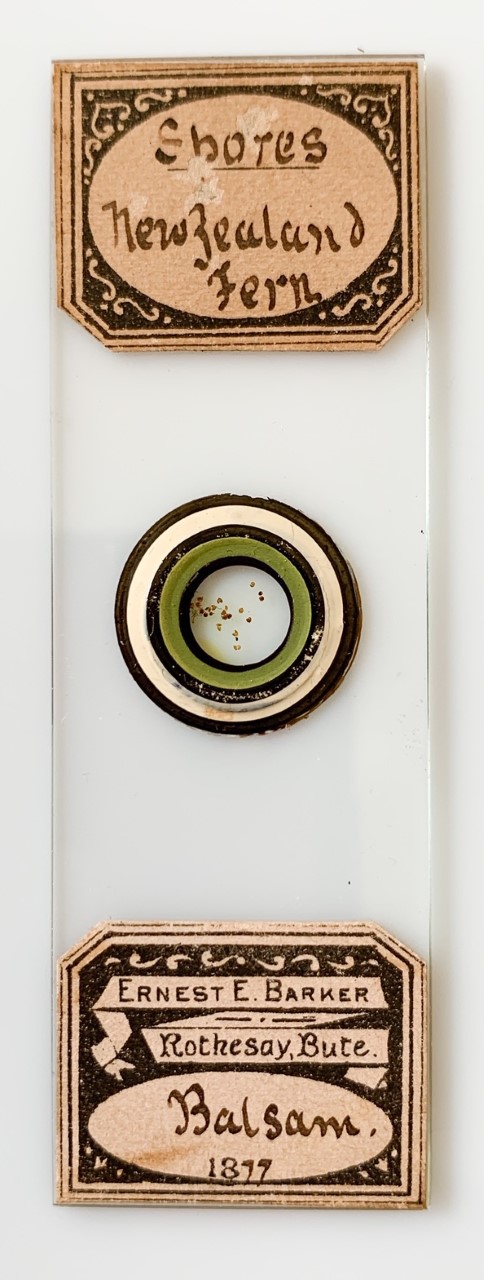
Figure 1.
Dated 1877, a microscope slide of spores from a New Zealand fern, bearing Ernest E. Barker's custom-printed label with his address of Rothesay, Bute, Scotland. At that time, Barker was the curator and manager of the Rothesay Royal Aquarium.
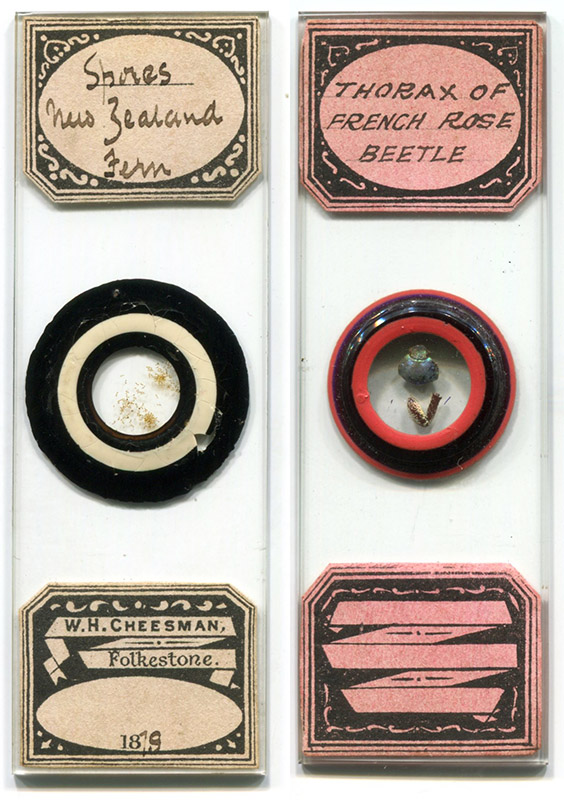
Figure 2.
Two slides by other mounters, with labels similar to those used by E.E. Barker in 1877. The labels of the slide on the left are identical to Barker's, except for the mounter's name and address, and were undoubtedly ordered by those two people from the same printing company. Scientific magazines of the period contained advertisements for production of custom-made slide labels. It is particularly notable, however, that the slide on the left, by William H. Cheesman, of Folkestone, Kent, and dated 1878, contains spores from a New Zealand fern, the same specimen as Barker mounted in the 1877 slide shown in Figure 1. This coincidence suggests that Barker and Cheeseman both purchased from (or traded with) the same supplier of microscopical objects. Several businesses sold unmounted objects for amateur slide-makers such as Barker and Cheesman. One wonders whether the same firm supplied Barker and Cheesman with both their customize labels and the specimens?
The slide on the right carries labels that are very similar to Barker's and Cheesman's, but lack the customize printing.
Ernest Enoch Barker was born during the summer of 1849. He was at least the fourth child, and second son, of Francis and Harriet Barker. Father Francis was a Wesleyan minister. Ernest received a good education: the 1861 census recorded that the then eleven year old boy was a student in a boarding school in Thirsk, Yorkshire.
By the early 1870s, Ernest Barker had moved to Glasgow, Scotland. He married Catherine Ferguson there on March 4, 1873. The 1875 Glasgow Electoral Register listed Barker as living at 68 Cambridge Street, and employed as a "manager". The nature of that work is not certain.
The Rothesay Aquarium, on the Isle of Bute, opened to the public on June 29, 1876, with Ernest Barker as the curator and manager (Figure 3). He wrote an article on the "short sunfish" for The Zoologist in August, 1876. The aquarium was some 50+ miles from Glasgow, involving a ferry across the Clyde, so it can be assumed that Barker lived in Rothesay at that time. The aquarium was designated “Royal” on September 30, 1876, after a visit by Prince Leopold.
It was during his time in Rothesay that Barker prepared his known microscope slides (Figure 1). It is not known whether he was a member of a scientific society at the time, or was involved in exchange of slides with other microscope enthusiasts.
By 1883, Barker was back in Glasgow, living at 10 Grafton Square. That year's Electoral Register stated his occupation as "designer". A history of the time states that Barker was then an "art teacher at the Ladies' College, Bath Street, Glasgow and at many other west-end schools", while also operating a shop called "The Japanese House". The UK and Japan had developed strong relations at this time, and Japanese art, furniture, and other items were in high demand. Barker's shop was described as having "one of the best collections of oriental and art objects to be found in Scotland, (which) combined the useful with the ornamental. Draught-screens, Chippendales, cabinets, mirrors exquisitely painted, flush frames for photos and so on … china and bronze including statuettes can also be selected from his legendary stock".
Also in 1883, Barker was elected to membership in the Natural History Society of Glasgow. On February 26, 1884, he "exhibited a gigantic Spider-crab from Japan, measuring 12 feet across between the points of the nippers. Mr. Barker stated that he believed the species to be Inachus kempferi, and he made some remarks on the habits of large marine crustaceans of this class."
Barker exhibited at the 1887 Royal Mining, Engineering and Industrial Exhibition in Newcastle upon Tyne, England. He displayed "the various processes of silk-making from the worm to the loom" Additionally, "Ye Fancy Goods Store (was) fitted up by Mr. Ernest E. Barker, 38 Bath Street, Glasgow."
He still maintained multiple businesses: the 1887 Post Office Directory of Glasgow listed Barker as, "art teacher, College of Science and Arts".
1891 found Barker and family in Fulham, London. That year's census listed his occupation as "grocer and licensed victualler, stocktaker".
Barker was elected as a Fellow of the Royal Microscopical Society on April 18, 1900. He presumably still made microscope slides at that time, although no examples are known to me. The month before his election, Barker exhibited a small, portable microscope to the RMS (Figure 4). Some time later, an engraving of the microscope and information on its manufacture were published in the Journal of the Royal Microscopical Society (Figure 4).
The 1901 census of England listed Barker's occupation as "manager of public company". But, that December, The London Gazette listed among their bankrupts, "Ernest Enoch Barker, 41 Melrose Gardens, Hammersmith, in the county of London, clerk".
On October 21, 1902, Ernest Barker and his family left England, arriving in Sydney, Australia on December 4. He soon joined the Field Naturalists' Club of Victoria.
Barker resumed his early profession of drawing instruction. In 1909, he was awarded a certificate from the Department of Education, Technical Schools in Model Drawing for his work at Horsham Working Men's College. His 1912 voter registration listed him as a "teacher of drawing".
Barker took at least one, and possibly two, long trips in his remaining years. He landed in Honolulu, Hawaii on December 11, 1917, having traveled from Sydney. He died on August 5, 1920, in Jaffna, Ceylon (Sri Lanka). The purpose of those voyages is not known.
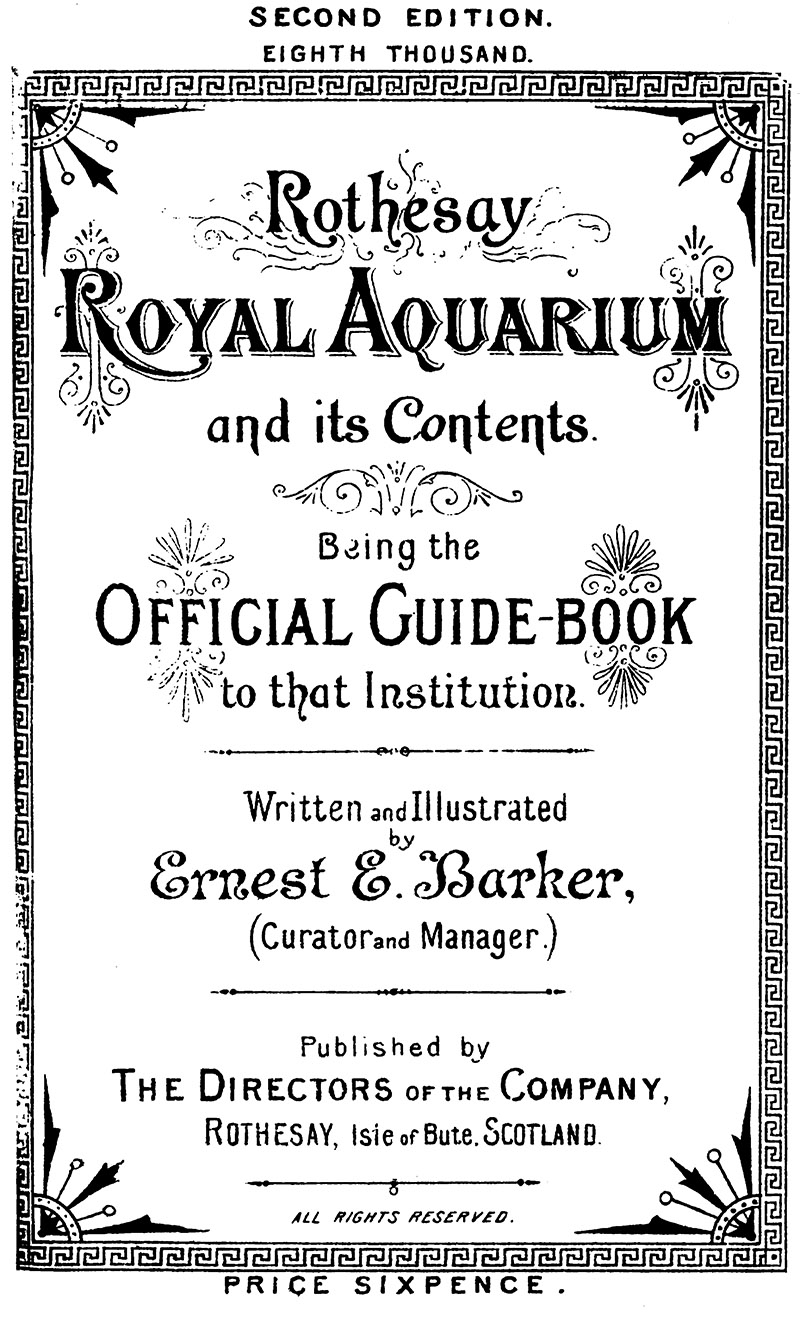
Figure 3.
Title to the Official Guidebook to the Rothesay Royal Aquarium, by Ernest E. Barker.
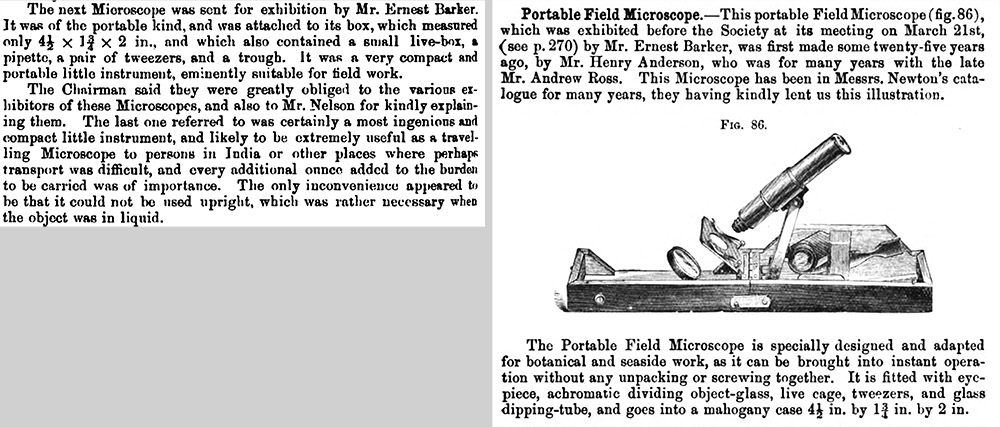
Figure 4.
Excerpts from the Journal of the Royal Microscopical Society, 1900. Ernest Barker exhibited a small, folding microscope in March of that year. It was later recognized as the design of microscope-maker Henry Anderson, whose biography can also be read on these pages.
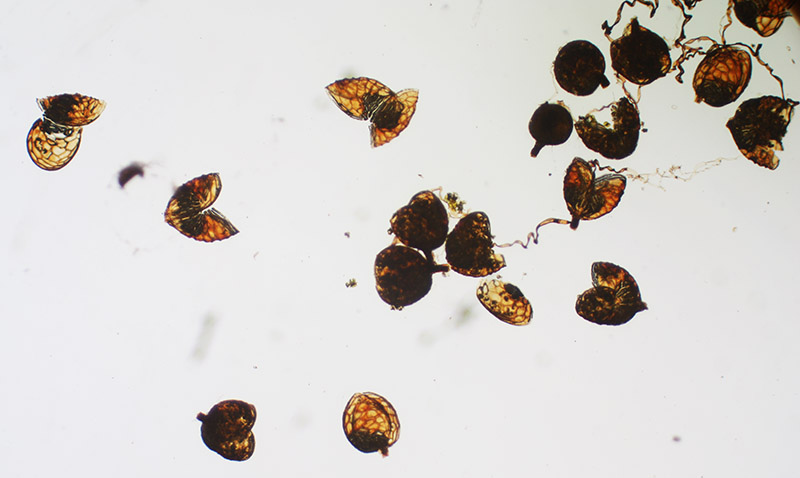
Figure 5.
Spores from a New Zealand fern, prepared in 1877 by E.E. Barker (see Figure 1). Photographed with a 3.5x objective lens and C-mounted digital SLR camera.
Resources
Australia voter records (1912) "Barker, Ernest Enoch, senior, Maclachlan st., Horsham, tchr. drawing", accessed through ancestry.com
Barker, Ernest E. (1876) Short sunfish, The Zoologist, page 5087
Barker, Ernest E. (1877) Lobster burying its prey, The Zoologist, page 261-262
Barker, Ernest E. (1878) Rothesay Royal Aquarium and its Contents: Being the Official Guide Book to That Institution
Checkland, Olive (2003) Japan and Britain After 1859: Creating Cultural Bridges, RoutledgeCurzon, London, page 194
Department Of Education (Australia) 1909) Certificate awarded to Ernest E. Barker, Technical Schools in Model Drawing, http://www.goldmuseum.com.au/ehive-object-details/265249/
Edinburgh Gazette (1901) Bankrupts, from the London Gazette, page 1407
Emigration record of Ernest E. Barker (1902) accessed through ancestry.com
England census and other records, accessed through ancestry.com
Glasgow Electoral Register (1875) accessed through ancestry.com
Glasgow Electoral Register (1883) accessed through ancestry.com
Glasgow Electoral Register (1888) accessed through ancestry.com
Journal of the Royal Microscopical Society (1900) pages 270-271, 379, and 409
Official Catalogue of the Royal Mining, Engineering and Industrial Exhibition (1887) pages 84 and 249
Post Office Directory of Glasgow (1887) page 125
Proceedings of the Natural History Society of Glasgow (1883) Minutes of the meeting of April 24, 1883, Vol. 5, page 310
Proceedings and Transactions of the Natural History Society of Glasgow (1884) Minutes of the meeting of February 26, 1884, New Series, Vol. 1, page xix
Proceedings and Transactions of the Natural History Society of Glasgow (1885) Minutes of the meeting of February 24, 1885, New Series, Vol. 1, page xlvi
The Victorian Naturalist (1906) Field Naturalists' Club of Victoria, Vol. 22, page 147




